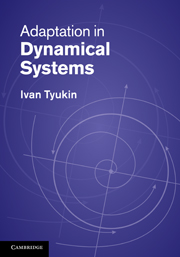Book contents
- Frontmatter
- Contents
- Preface
- Notational conventions
- Part I Introduction and preliminaries
- Part II Theory
- 4 Input–output analysis of uncertain dynamical systems
- 5 Algorithms of adaptive regulation and adaptation in dynamical systems in the presence of nonlinear parametrization and/or possibly unstable target dynamics
- Part III Applications
- Appendix. The Meyer–Kalman–Yakubovich lemma
- References
- Index
5 - Algorithms of adaptive regulation and adaptation in dynamical systems in the presence of nonlinear parametrization and/or possibly unstable target dynamics
from Part II - Theory
Published online by Cambridge University Press: 03 May 2011
- Frontmatter
- Contents
- Preface
- Notational conventions
- Part I Introduction and preliminaries
- Part II Theory
- 4 Input–output analysis of uncertain dynamical systems
- 5 Algorithms of adaptive regulation and adaptation in dynamical systems in the presence of nonlinear parametrization and/or possibly unstable target dynamics
- Part III Applications
- Appendix. The Meyer–Kalman–Yakubovich lemma
- References
- Index
Summary
In this chapter we discuss a range of synthesis problems in the domain of adaptive control and regulation for dynamical systems with nonlinear parametrization and, possibly, unstable target dynamics. Results presented in the previous chapters, such as e.g. the bottle-neck principle and (non-uniform) small-gain theorems from Chapter 4, will play important roles in the development of suitable formal statements of these problems. In particular, when specifying the target dynamics of an adapting system, we will exploit input–output characterizations such as input–state and input–output margins, and majorizing of mappings and functions. No stability requirements will be imposed on the target motions in the adapting system a priori. This will offer us greater flexibility and thus will create opportunities to overcome certain limitations of standard approaches (see Chapter 3) with regard to the target dynamics and nonlinear parametrization.
We begin by stating the general problem of adaptation and adaptive regulation and providing a set of solutions to this problem. Having developed these solutions, we will proceed by considering several specific problems of adaptation. These problems are
(1) adaptive regulation to invariant sets;
(2) adaptive control of interconnected nonlinear systems;
(3) parametric identification of systems of ordinary differential equations with monotone nonlinear parametrization;
(4) non-dominating adaptive control and identification for systems with general nonlinear parametrization of uncertainties.
In order to provide particular solutions to the general problem of adaptation and also to the specific problems (1)–(4) we introduce a synthesis method – the method of the virtual adaptation algorithm.
- Type
- Chapter
- Information
- Adaptation in Dynamical Systems , pp. 151 - 262Publisher: Cambridge University PressPrint publication year: 2011



